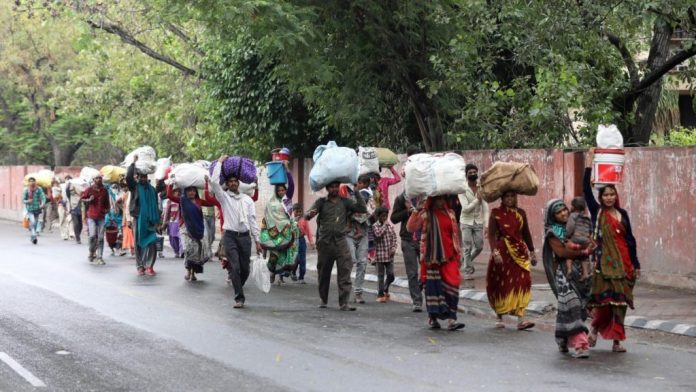This article is written by Bhaskar Tryambakrao Behere, pursuing a Certificate Course in Labour, Employment and Industrial Laws for HR Managers from LawSikho.
Table of Contents
Introduction
COVID-19 pandemic impacted millions of families across the country. The Central Government had imposed a nationwide lockdown to control the spread of COVID-19. It was one of the necessary measures to control the spread of a deadly virus. During the pandemic migrant workers have faced various hardships. All workplaces except essential services were shut down due to a lockdown imposed by the government of India. Millions of workers have lost their jobs. They had to face hardships like loss of income, shortage of food, and uncertainty about their future. Due to the nationwide lockdown, there was no transportation. So, thousands of them started walking back to native places. Many of them lost their loved ones during this journey.
In this difficult situation, millions of workers lost their jobs and income. According to information submitted by the Labour and Employment Minister Santosh Kumar Gangwar in Parliament, 10 million migrants attempted to return home. In the No work No money and no transportation situation, migrant workers started walking back home. Also, in hopes of getting any means of transportation, thousands of migrants have seen at the bus stops and on the railway stations. Failing to observe social distancing, fiasco occurred.
Although there is an act in India, Inter-State. Migrant Workmen (Regulation of Employment and Conditions of Service) Act, 1979, for regulation of employment of migrant workers, no proper data or monitoring system for migrants is in place. According to The International Labour Organisation (ILO), 400 million migrants would be impacted due to the lockdown imposed by the country. According to the 2011 Census of India, Maharashtra State has the largest number of migrants.
The Central Government and State Governments took various steps to resolve the problems of migrant workers. To provide food grains, the Government announced additional rations for free to poor people. Also, the government announced the One Nation-One Ration Card scheme. Migrant workers were allowed to receive food grains for free of charges from anywhere across the country. Due to a lack of awareness, many of them didn’t receive rations from the government. According to a survey published by ‘The Hindu’, 96% of migrant workers didn’t get rations.
Various Measures: During the nationwide lockdown The Central Government and State Governments took various measures to house the migrant workers and to mitigate the impact of pandemic on them.
Directives: for providing relief to migrants during the lockdown, the government passed some directives to states.
On March 27, 2020, the Home Ministry ordered state governments to ensure that migrants would not move during the lockdown.
On March 28, 2020, states were permitted to use the National Disaster Response Fund (NDRF) to provide shelter and food to the migrants.
Also, the government issued orders that landlords should not demand rent during this period. Due to the shutdown of workplaces, employers imposed a No Work No Pay policy. In this regard, the government issued orders that employers should pay wages to workers without deduction. Due to the extension of lockdown, the order of payment of wages was withdrawn on 17 May, 2020. State Governments were asked to set up relief camps for the migrants.
On May 16, 2020, the government announced the National Migrants Information System (NMIS). It is an online database of migrants created by the National Disaster Management Authority (NDMA). The government planned to streamline current numbers of migrants, movement of them, and keep them updated by feeding their contact numbers in the system.
On July 14, 2020, the Ministry of Human Resources Development requested the states to create a database of children from rural areas who have migrated.
Food and Relief Camps
By setting up relief camps, state governments and NGOs provided shelter and food to lakhs of migrants. As of late March 2020, Delhi Government provided free food to four lakh migrants every day. As of the first week of April 2020, over 12.5 lakh migrants had been shifted to 28000 relief camps across the country and over 75 lakh people were provided food by state governments, UTs, and NGOs.
Transportation
Many of the migrants were stranded till the last week of April 2020. The Central Government permitted state governments to operate buses. As of the last week of May 2020, 4 million migrants travelled by buses. Due to overcrowding in buses, it was difficult to observe social distancing. Everyone wanted to get a bus anyway. Nobody was concerned about social distance.
On May 1, 2020, the Central Government permitted the launch of ‘Shramik Special’ trains for migrants. This service was not free. Travellers needed to pay additionally over the normal fares. Later, the Central Government had to face criticism from the opposition. Then the Central Government announced that Indian Railway would offer an 85% subsidy and state governments would pay the remaining 15%. It was a big relief for migrants. Large number of migrants travelled by Shramik Special trains.
Migrants faced hardships while travelling by trains. They reported that there was no food, water, and sanitation facilities. According to data from Railway Protection Force, between May 9 and 27, 2020 there have been almost 80 deaths on board Shramik Special Trains.
Relief measures announced by Finance Minister
To ease the economic impact of the pandemic, Finance Minister Nirmala Sitharaman announced a spending plan of INR 1.7 Lakh Crore for poor people. It included cash transfers as well as food security.
To provide food and shelter to migrants, the central government released INR 11092 Crore to states and UTs under the NDRF.
As of April 1, 2020, wages under MGNREGA were increased to INR 202 from INR 182.
On May 13, 2020, INR 1000 Crore was allocated from the PM CARES Fund for the support of migrant workers. On May 14, 2020, Finance Minister Sitharaman announced free food grains for migrant workers. Nearly 8 crore migrants are not covered under the food distribution system. 5kg of grains per person and 1kg chana per family was provided to them for 2 months for free.
On June 20, 2020, the Central Government launched Garib Kalyan Rojgar Yojana. It was initiated to tackle the impact of a pandemic on migrant workers.
By providing an economic stimulus package, the Finance minister tried to mitigate the economic impact of the pandemic on migrants and farmers. FM announced INR 1500 Crore for MUDRA Shishu loans and INR 86600 approved for agriculture loans between March 1, 2020 and April 30, 2020. Also provided concessional credit of 2 Lakh Crore to farmers under PM KISAN. Scheme of INR 5000 Crore announced to provide easy access for street vendors.
Quarantine Facilities
It was reported by many states that a high number of COVID 19 positive cases were found among the migrant workers. To tackle this issue state governments opened quarantine centres for migrants. Also states imposed strict measures to follow while entering and leaving state borders.
PIL in Supreme Court
- Alakh Alok Srivastava Vs UOI (468/2020) was filed by advocate practising in supreme court for seeking immediate steps to be taken to provide protection to rights of migrants and they shall be provided essentials like food, drinking water, shelter and medical help.
- Harsh Mander & Anr. Vs Union of India (10801/2020) was filed by social activist Mr. Harsh Mander and RTI activist, Ms. Anjali Srivastav. This petition was filed seeking immediate action to be taken to ensure payment of wages to migrants and demand of rent by landlords during the lockdown.
During the hearing, the Central Government submitted the report of measures taken for migrants pertaining to providing all basic amenities like food, drinking water, medicines, etc.
During the hearing, the Court opined that dealing with the crisis of health management and that policy decisions were the prerogative of the Government. If the Court passes directions as per petition, it will amount to the Court running the Government.
Controversy: according to Rashmi Bansal (Petitioner), in the report of the Central government, details pertaining to sanitisation and social distancing in shelters provided for migrants were not mentioned. As per a report of Al Jazeera, migrants in UP were doused in disinfectants.
Conclusion
During the nationwide lockdown and shutdown of workplaces, migrants had to face so many problems. Loss of job, loss of income and uncertainty of future made their life worse. The Central Government and States had tried to provide some relief measures to mitigate the impact of the pandemic. The Central Government, States and NGOs food and relief camps and free food grains for the poor. Also, the Finance Minister announced various schemes under the economic stimulus package.
Even though various measures taken by the government to mitigate the impact, migrants are still affected by the pandemic. Many of them have lost their jobs and lost a source of income. These problems may not be resolved until concrete measures are taken. We hope the impact of the COVID-19 pandemic will be resolved very soon.
References
- https://www.tribuneindia.com/news/nation/over-75-lakh-being-fed-at-food-camps-mha-66223
- https://www.hindustantimes.com/india-news/railway-protection-force-reports-80-deaths-on-shramik-trains/story-psJl3EenY4B0uUYMRvkChL.html
- https://www.thehindu.com/business/Economy/second-tranche-of-economic-package-to-benefit-migrant-workers-small-farmers-nirmala-sitharaman/article31583468.ece
- https://www.mondaq.com/india/litigation-contracts-and-force-majeure/928584/migrant-workers39-covid-19-measures-pil-update
Students of Lawsikho courses regularly produce writing assignments and work on practical exercises as a part of their coursework and develop themselves in real-life practical skills.
LawSikho has created a telegram group for exchanging legal knowledge, referrals, and various opportunities. You can click on this link and join:
 Serato DJ Crack 2025Serato DJ PRO Crack
Serato DJ Crack 2025Serato DJ PRO Crack











 Allow notifications
Allow notifications



